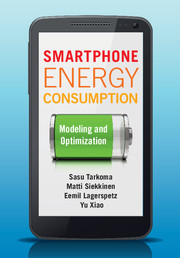Book contents
- Frontmatter
- Contents
- Preface
- List of abbreviations
- Part I Understanding energy consumption
- Part II Energy management and conservation
- 6 Overview
- 7 Smartphone subsystems
- 8 Mobile operating systems
- 9 Power modeling
- 10 Power profilers
- Part III Advanced energy optimization
- Appendix A An energy profile application
- Index
- References
6 - Overview
from Part II - Energy management and conservation
Published online by Cambridge University Press: 05 August 2014
- Frontmatter
- Contents
- Preface
- List of abbreviations
- Part I Understanding energy consumption
- Part II Energy management and conservation
- 6 Overview
- 7 Smartphone subsystems
- 8 Mobile operating systems
- 9 Power modeling
- 10 Power profilers
- Part III Advanced energy optimization
- Appendix A An energy profile application
- Index
- References
Summary
A mobile device consists of hardware components, such as microprocessors, wireless network interfaces, display and touchscreen, storage, cameras, and sensors; and software including the operating system and applications. To understand and optimize energy consumption, models are needed for the subsystems and components of the smartphone, including the OS and applications.
In this chapter, we give an overview of the smartphone energy consumption and the methodologies that can be used for power modeling and optimization. We aim to answer the question: where is the smartphone energy spent? and its follow-up question: how can we maximize the energy efficiency?
Methodology
To address the above questions, the first thing we need is a well-defined and rigorous methodology.
Energy profiling terminology
For a thorough treatment of a topic, it is generally important that the core concepts are properly named and that the terminology is consistent and well understood. Otherwise, it is difficult to grasp what exactly is software-based energy profiling and optimization. Furthermore, as we will see especially in the profilers section, the literature is rich with plenty of different kinds of solution which are presented as unique tools but are often combinations of different kinds of underlying techniques. Hence, it is necessary to be able to categorize these solutions and to analyze their advantages and disadvantages, which requires a good understanding of the relevance of the different components of an individual energy profiler, such as a specific power-modeling technique. For these reasons, we briefly define here the most important terms that we use in this part.
- Type
- Chapter
- Information
- Smartphone Energy ConsumptionModeling and Optimization, pp. 83 - 91Publisher: Cambridge University PressPrint publication year: 2014



